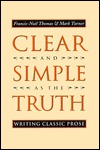

 |

|

The average rating for Clear and simple as the truth based on 2 reviews is 4 stars.
Review # 1 was written on 2011-02-19 00:00:00 Mark Provenzano Mark ProvenzanoThis is not Strunk and White. And it's not really about sentences and phrases. It's about ontology--which Thomas and Turner call 'theology.' Basically, there was a way of writing that begins in earnest around Descartes' "Discourse on Method," was widely adopted by French writers of the 17th century, and can be found in American writers from Franklin and Jefferson to Samuel Clemens to A. J. Liebling. Thomas and Turner dub this mode of writing "the classic style." The classic style assumes that reality is orderly and capable of being represented: think Foucault's classical episteme, but applied to style--that will give you an idea of the power of T&T's insight. The classic style argues without seeming to argue. All the work of presentation is hidden. Everything is laid out for the reader to find. The audience is assumed to have the same powers and capacities as the writer. The only appeals made are to facts, inspection, and an assumed common intelligence and set of cultural coordinates. The classic style is not the plain style: it does not assume all knowledge boils down to universal verities; it does not make truth simple; the classic style is always one degree removed from the plain style. In short, the audience is "universal"--even though this universality is a construct. Most interesting for me: Thomas & Turner distinguish classic writing from practical writing. Practical writing is what you find in business memo's--and scholarship. It's specialists talking to each other about technical problems. Practical writing doesn't assume universal knowledge; it assumes a practical orientation--an orientation towards common ends and arguments about means, you might say. In short, T&T 'explain' why scholarly writing cannot reach a wide audience: it's a business memo for folks with Ph.D.'s. Those who can write for a wide audience, those few, pass over to a different domain: the public intellectual--often looked down on as 'popularizers' by the specialists. In short, this is a book about writing, but it's also much much more. The second half of the book, a 'museum' of examples all elegantly glossed, is worth the price of admission. Buy it if you think and care about writing. Otherwise, just stick with your Strunk & White. What about the world could have changed since 1935? |
Review # 2 was written on 2012-07-16 00:00:00 Adam Hiltebeitel Adam HiltebeitelMoved to gwern.net. |
CAN'T FIND WHAT YOU'RE LOOKING FOR? CLICK HERE!!!